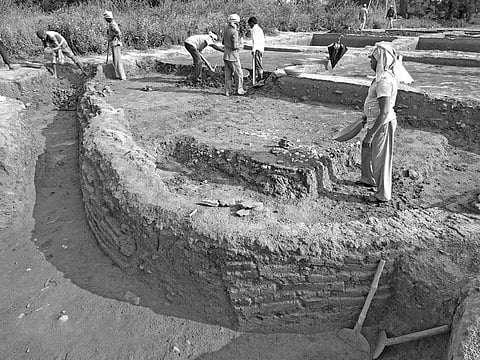

BHUBANESWAR: The ancient Asurgarh fort site near Narla block in Kalahandi district which was believed to be of Mauryan period - 322 to 185 BC - actually belongs to the Iron Age.
This has been revealed in the international journal ‘Heritage: Journal of Multidisciplinary Studies in Archaeology’ published a week back.
The journal which has reported the Accelerator Mass Spectrometry (AMS) dating of the site stated that study has pushed back the antiquity of the Asurgarh settlement to around 3,000 years old belonging to the Iron Age.
Going by the dating, it can be safely said that the fort site is older than Sisupalgarh which is considered to be of 5-6th century BC, around 2,500-2,600 years old, said ASI’s excavation wing chief DB Gadanayak who oversaw the excavation in Asurgarh in 2018-19. AMS dating of remains from Sisupalgarh site is yet to be done.
He further said that the knowledge of iron metallurgy had significant influence over the socio-economic life and growth of fortified settlements in the State.
Asurgarh is one of the sites which has its beginning in around 8th-9th century BC and emerged as one of the early urban fortified settlements in the region by the efforts of tribal and non-tribal inhabitants of the region.
“People of that period had a good knowledge of iron technology and use of iron implements. The iron materials found during excavation at Asurgarh site have not rusted yet as the Fe content in them was extremely high,” said Gadanayak.
Lokesh Durga, Ph. D scholar in the Department of History of Delhi University, working on Settlement History of Premodern Odisha, says Asurgarh settlement is older than Sisupalgarh and the first urbanisation process in Odisha started from Asurgarh.
“There is a hiatus in the understanding of social formation process in the early historic period in Odisha and the present archaeological findings indicate that there was social hierarchy in Odisha in the beginning of first millennium A.D. Thanks to the efforts of the tribesmen of the region who built the Asurgarh settlement in the 8th-9th century BC which emerged as one of the oldest and longest fortified settlements in premodern Odisha,” added Durga.
Earlier in 2019, silver coins, jewellery, precious beads and rare terracotta excavated from Asurgarh had pointed to the existence of a civilisation dating 2,300 years back (3rd century BC) - from Mauryan to Kushan period.
As per dating of material remains retrieved from the excavation conducted at Inter-University Accelerator Centre in New Delhi, the whole cultural period of the site is divided into three cultural phases within a time bracket from 9th BC to 2nd-3rd century AD. The excavation revealed three major periods of human occupation without any hiatus - Iron Age, Early Historic Period and Late Period.
The site was declared protected under the Ancient Monuments and Archaeological Sites and Remains Act, 1958 in 1973. Asurgarh fort consists of main fort and exterior fortification. The main fortification spreads over 12 hectare and there was also an external fortification, which is now in ruins.
At present, the height and width of the fortified wall measure 11 mx7.5 m and the encircled moat measures 36 m in width.